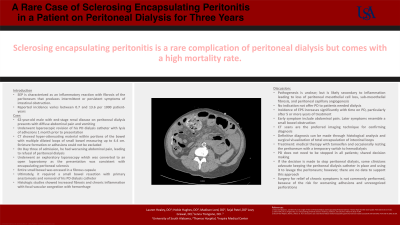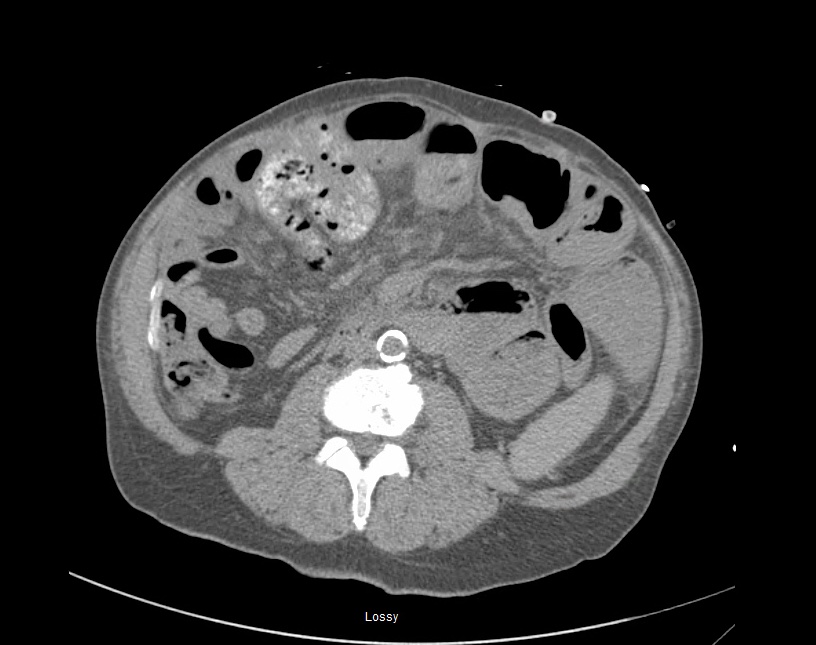Tuesday Poster Session
Category: Small Intestine
P5025 - A Rare Case of Sclerosing Encapsulating Peritonitis in a Patient on Peritoneal Dialysis for Three Years
Tuesday, October 29, 2024
10:30 AM - 4:00 PM ET
Location: Exhibit Hall E

Has Audio

Lauren Healey, DO
USA Health, University of South Alabama
Daphne, AL
Presenting Author(s)
Lauren Healey, DO1, Hobie Hughes, DO2, Madison Lord, DO3, Sejal Patel, DO4, Lovy Grewal, DO4, Jenna Trongone, MD4
1USA Health, University of South Alabama, Williamstown, NJ; 2Jefferson Health, Williamstown, NJ; 3Inspira, Haddon Heights, NJ; 4Inspira Health Network, Vineland, NJ
Introduction: Sclerosing encapsulating peritonitis (SEP) is a rare but potentially fatal complication of peritoneal dialysis (PD). The mortality rate of SEP is high and there should be high suspicion when assessing peritoneal dialysis patients with abdominal pain. SEP is characterized as an inflammatory reaction with fibrosis of the peritoneum that produces intermittent or persistent symptoms of intestinal obstruction. Diagnostic criteria, per the International Society for Peritoneal Dialysis (ISPD) depends on the presence of clinical symptoms and radiological findings of peritoneal thickening, calcification, intestinal obstruction, and encapsulation.
Case Description/Methods: A 62-year-old male with end-stage renal disease on peritoneal dialysis presents with diffuse abdominal pain and vomiting. One month prior, he had a laparoscopic revision of his PD dialysis catheter with lysis of adhesions. A CT showed hyper-attenuating material within portions of the bowel with multiple dilated loops of small bowel measuring up to 4.4 cm. Stricture formation or adhesions could not be excluded. He was evaluated by the surgical team and treated with nasogastric tube decompression. By day three of admission, he had worsening abdominal pain, leading to refusal of peritoneal dialysis. He underwent an exploratory laparoscopy which was converted to an open laparotomy as the presentation was consistent with encapsulating peritoneal sclerosis. It was noted that his whole small bowel was encased in a fibrous capsule. Ultimately, it required a small bowel resection with primary anastomosis and removal of his PD dialysis catheter. Histologic studies showed increased fibrosis and chronic inflammation with focal vascular congestion with hemorrhage. He was subsequently transferred to ICU for further management.
Discussion: Early presenting gastrointestinal symptoms of EPS are vague; including anorexia, nausea, and vomiting. Symptoms also tend to be intermittent, making the diagnosis difficult. Later stages present with symptoms that resemble a small bowel obstruction, including abdominal pain and constipation. However, given the high mortality rate, SEP should be on the differential diagnosis for patients on peritoneal dialysis. CT scans are the preferred imaging technique for confirming diagnosis. A definitive diagnosis can be made through histological analysis and surgical visualization of total encapsulation of intestinal loops.

Disclosures:
Lauren Healey, DO1, Hobie Hughes, DO2, Madison Lord, DO3, Sejal Patel, DO4, Lovy Grewal, DO4, Jenna Trongone, MD4. P5025 - A Rare Case of Sclerosing Encapsulating Peritonitis in a Patient on Peritoneal Dialysis for Three Years, ACG 2024 Annual Scientific Meeting Abstracts. Philadelphia, PA: American College of Gastroenterology.
1USA Health, University of South Alabama, Williamstown, NJ; 2Jefferson Health, Williamstown, NJ; 3Inspira, Haddon Heights, NJ; 4Inspira Health Network, Vineland, NJ
Introduction: Sclerosing encapsulating peritonitis (SEP) is a rare but potentially fatal complication of peritoneal dialysis (PD). The mortality rate of SEP is high and there should be high suspicion when assessing peritoneal dialysis patients with abdominal pain. SEP is characterized as an inflammatory reaction with fibrosis of the peritoneum that produces intermittent or persistent symptoms of intestinal obstruction. Diagnostic criteria, per the International Society for Peritoneal Dialysis (ISPD) depends on the presence of clinical symptoms and radiological findings of peritoneal thickening, calcification, intestinal obstruction, and encapsulation.
Case Description/Methods: A 62-year-old male with end-stage renal disease on peritoneal dialysis presents with diffuse abdominal pain and vomiting. One month prior, he had a laparoscopic revision of his PD dialysis catheter with lysis of adhesions. A CT showed hyper-attenuating material within portions of the bowel with multiple dilated loops of small bowel measuring up to 4.4 cm. Stricture formation or adhesions could not be excluded. He was evaluated by the surgical team and treated with nasogastric tube decompression. By day three of admission, he had worsening abdominal pain, leading to refusal of peritoneal dialysis. He underwent an exploratory laparoscopy which was converted to an open laparotomy as the presentation was consistent with encapsulating peritoneal sclerosis. It was noted that his whole small bowel was encased in a fibrous capsule. Ultimately, it required a small bowel resection with primary anastomosis and removal of his PD dialysis catheter. Histologic studies showed increased fibrosis and chronic inflammation with focal vascular congestion with hemorrhage. He was subsequently transferred to ICU for further management.
Discussion: Early presenting gastrointestinal symptoms of EPS are vague; including anorexia, nausea, and vomiting. Symptoms also tend to be intermittent, making the diagnosis difficult. Later stages present with symptoms that resemble a small bowel obstruction, including abdominal pain and constipation. However, given the high mortality rate, SEP should be on the differential diagnosis for patients on peritoneal dialysis. CT scans are the preferred imaging technique for confirming diagnosis. A definitive diagnosis can be made through histological analysis and surgical visualization of total encapsulation of intestinal loops.

Figure: CT scan showing concerns for stricture formation or adhesions in the small bowel
Disclosures:
Lauren Healey indicated no relevant financial relationships.
Hobie Hughes indicated no relevant financial relationships.
Madison Lord indicated no relevant financial relationships.
Sejal Patel indicated no relevant financial relationships.
Lovy Grewal indicated no relevant financial relationships.
Jenna Trongone indicated no relevant financial relationships.
Lauren Healey, DO1, Hobie Hughes, DO2, Madison Lord, DO3, Sejal Patel, DO4, Lovy Grewal, DO4, Jenna Trongone, MD4. P5025 - A Rare Case of Sclerosing Encapsulating Peritonitis in a Patient on Peritoneal Dialysis for Three Years, ACG 2024 Annual Scientific Meeting Abstracts. Philadelphia, PA: American College of Gastroenterology.
